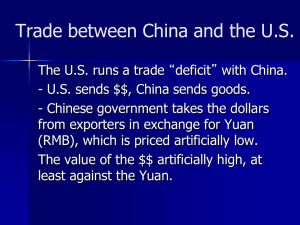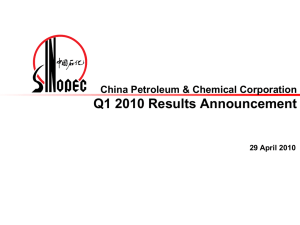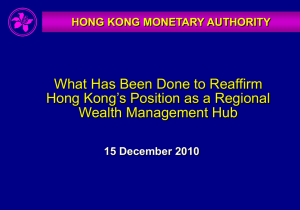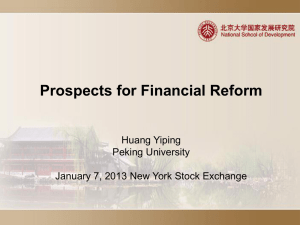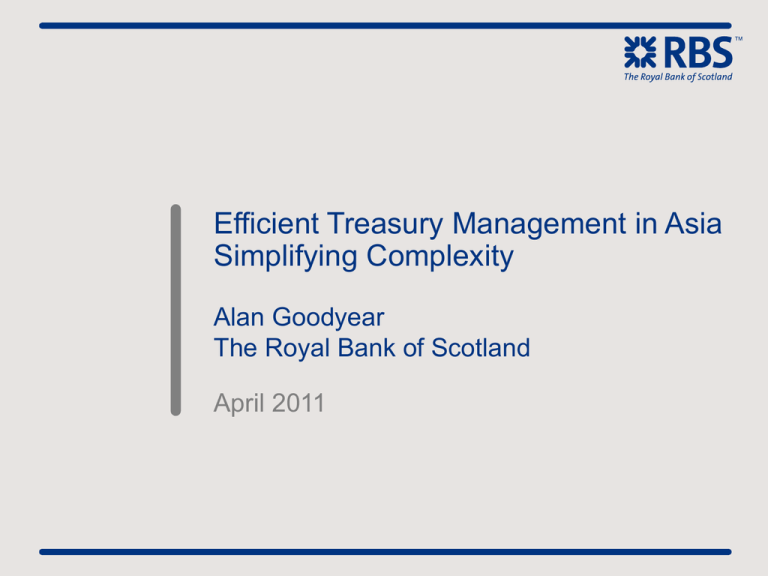
Efficient Treasury Management in Asia
Simplifying Complexity
Alan Goodyear
The Royal Bank of Scotland
April 2011
Coming soon to a theatre near you…. Asia
Starring: India and China
Co-starring: Singapore and
Hong Kong
Introducing: Indonesia, and
Malaysia
RBS58178
Asia’s response to the economic crisis
Pre crisis – 2007
•
•
•
•
One of the world’s top ten companies by revenue was Asian
162 of the top 500 were US companies
China and India had 30 companies within the top 500
Few Asian companies with professional treasury management
2010
•
•
•
•
•
•
•
Five of the world’s top ten companies by revenue are Asian
139 are US companies – 8.5% decrease
Chinese and Indian companies now number 54 – 57% increase
China ranks 3rd after US and Japan for number of companies in the top 500
Asian companies flush with cash, are professionalizing treasury management
Asian companies setting up regional treasury centers, eg Huawei, Haier, Tata, Sinopec
Asian companies are acquiring and investing offshore
RBS58178
Reality Check
• Selected acquisitions by Asian Companies – Jaguar, Rover, Volvo, IBM/Lenovo
• Growing importance and size of Asian Market:
– Telecom (mobile)
– Resources & Commodities
– Luxury Brands
• Increased Competition from Asian Companies
– Emergence of India and China
– Transfer of FX risk from China – RMB internationalization
• Gradual market reform
– Automation of clearing systems
– Currency bands widening
RBS58178
F
M
A
M
J
J
A
S
O
N
D
J
35
30
25
20
15
10
5
0
-5
-10
F
RBS58178
Jan-11
Dec-10
Nov-10
Oct-10
Sep-10
Aug-10
Jul-10
Jun-10
May-10
Apr-10
China Trade Balance
Mar-10
Mar-11
Feb-11
Jan-11
Dec-10
Nov-10
Oct-10
Sep-10
Aug-10
Jul-10
Jun-10
May-10
Apr-10
Mar-10
96
94
92
90
88
86
84
82
80
Feb-10
Japanese Yen to USD
Feb-10
Feb-11
Jan-11
Dec-10
Nov-10
Oct-10
Sep-10
Aug-10
Jul-10
Jun-10
May-10
Apr-10
Mar-10
Feb-10
Jan-10
The world is a risky place
China Interest Rates Value
6.2
6.0
5.8
5.6
5.4
5.2
5.0
4.8
India Interest Rates Value
6.0
5.5
5.0
4.5
4.0
3.5
3.0
Treasury Management in Asia
•
•
•
•
•
Most global companies are now present in Asia in some capacity
All businesses are affected by Asian developments
Largest markets for Foreign Direct Investment, China and India, are also the most highly regulated in Asia
Optimal level of capital injection to reduce “trapped cash” in regulated countries
Type of establishment should be “fit for purpose”: impacts ability to repatriate profits
Small Companies
Large Companies
•
•
•
•
•
•
•
• Full functional suite: sales, design, R&D, treasury
• Empowered offshore/regional treasury staff
• Sophisticated treasury management systems with
Mainly sales focused
Alternatively small manufacturing or assembly
Financial expertise resides at headquarters
Limited treasury mass in Asia
Collections, transparency and control key concerns
Regular fund remittances to headquarters
Tends to trade in home currency if possible
tiered authorization structure
• Straight through processing/electronic collection
processes, automated fund sweeps, centralized liquidity
• Liquidity investment management
• Offshore pooled funding accounts
• Multi-currency, multi-jurisdictional receipts and
payments
RBS58178
Natural Progression of Company Set-Up in Asia
Functions Centralized
In-country
Bank Account
• Bank Accounts
• Invoicing
• Accounts Receivable
• Accounts Payable
• Accounting
• Payments
• Collections
• Intra-company Netting
Medium
Small
• Balance Management
• Cash Pooling
• Intercompany Funding
• FX / Interest
Management
• Long-term Funding
Single Regional /
Global Bank
Large
Domestic Plus
Regional Overlay
Bank
Centralized
Treasury
Shared
Service
Center
Payments
Factory
In-House
Bank
Decentralized
Treasury
Degree of centralization
RBS58178
Commercial Flows
Cash Flow Forecasting Challenges
Volume * Price = Revenue
• World politics unstable
• Clients demanding
• Global competition drive
prices
• FX volatility
Investing / Financing
• Interest rate rising
• Changing regulatory
environment
• Contractionary monetary
policy
COGS + SG&A
• Fast moving commodity prices
• FX volatility
• Wage inflation
Predictability is
Challenging!
RBS58178
The Voice of the Corporate
More than a third of
organizations keep the majority
of their liquidity in operating
accounts and short-term Time
Deposits
Only half of organizations
can accurately predict cashflows up to 4 weeks ahead
Customer Liquidity
Survey * 2010
* gtnews
Almost two thirds of
organizations rely on
operational cash-flow as
their top source of working
capital funding
RBS58178
Organizations find
‘’instrument credit rating’’,
‘’overnight liquidity’’ and
‘’investing with credit
providers’’ to be the top
factors that influence their
cash investment policy
On average,
organizations keep
almost 50% of their shortterm liquidity overnight
Working Capital Fundamentals have not Changed
Liquidity management
Efficient processing
Short-term investment
Transparency
Trapped cash
Yield enhancement
Measurement &
reporting
DPO, DSO, DIO
Stress testing
Cash conversion
Scenario modelling
Working
Capital
Market risk
Operational risk
Interest rate and FX risk
Credit risk
Counterparty risk
Risk management &
compliance
Standardization
Transaction analytics
STP
Data Transformation
Connectivity options
Multi-bank balance
reporting
Automated balance
transfers
Dashboard view
Hands-free
information
Visibility & Control
Supplier risk
Dispute management
Discounted receivables
STP
Balance sheet risk
Supply chain
RBS58178
Source: J&W Associates, 2009
Realities of Treasury Management in Asia
Challenges
• Globalization
– More currencies,
countries, entities
Treasury Objectives
Cash Visibility
Cash Control
Current and future
Concentrate cash
flows/positions
in one place
• Cash Flow Forecasting
– Timely information
• Risk management
– Counterparty
– Country
– Operational
Optimize Balance Sheet
Optimize Risk Return
Reduce LT debt
Enhance Yields
Reduce Working Capital
Reduce interest costs
– Legal, tax, accounting
• Account Complexity
– Managing multiple
accounts with multiple
banks
• Cash Concentration
– Manual transfers
between banks
• MM & FX
Increased Efficiency
Doing more with less
• Regulations
Challenges
– Processing internal and
external investments /
funding and FX Swaps
• Small treasury teams
• Different time zones
RBS58178
Asia Pacific Regulatory Landscape is Variable
Less Regulated Countries
Hong Kong
Singapore
Australia
Japan
More Regulated Countries
Indonesia
Korea
Malaysia
Thailand
China
•
•
•
•
Account opening for residents and non-residents
Local currencies are freely convertible
No restrictions on domestic or cross-border foreign exchange transactions
No restriction on in-country and cross-border cash sweeping and single-currency incountry and cross-border notional pooling
• Accounts held in these countries can be part of a global automated cross-border sweep
• HK and Singapore are popular locations for regional treasury centers due to nonrestrictive nature and low tax environment
• Varying degrees of stringent regulation, with India and China being the most highly
•
•
•
•
India
•
•
RBS58178
•
regulated
Local currencies are not freely convertible
Restrictions may apply on account openings by resident and/or non-resident entities in
local and/or foreign currency
Restrictions and reporting requirements may apply on domestic and/or cross-border
foreign exchange transactions
In some countries, cross-border remittances are restricted to settlement of trade
transactions, dividend payments, royalties, management fees, etc with documentary
proof of transactions required
Restrictions apply on domestic liquidity options: in most countries foreign currency
notional pooling is not allowed. In addition, local currency notional pooling is not allowed
in India and China. Restrictions may apply on domestic sweeping, especially between
resident and non-resident entities. Approvals/reporting may be required
Restrictions apply on accounts in these countries being a part of a global cross-border
sweep
Increasing liberalization and deregulation: eg. RMB cross-border trade settlements
Regulatory Framework in Asia is Complex
Australia
China
Hong Kong
India
Indonesia
Japan
Malaysia
Singapore South Korea
Thailand
In Local Currency
√
√
√
√
√
√
√
√
√
√
In Foreign Currency
√
√^
√
√*
√
√
√^
√
√
√^
In Local Currency
√
√^
√
√*
√^
√
√
√
√
√
In Foreign Currency
√
√^
√
√*
√^
√
√^
√
√
√^
In Local Currency
√
√*
√
x
x
√
x
√
x
x
In Foreign Currency
Availability of Accounts/Services
By Resident Entities
Opening of Onshore
Accounts
By Non-resident
Entities (with no PE)
Opening of Offshore
Accounts
Accessing of Short
Term Overdraft
Facilities
By Resident Entities
√
√*
√
√*
√
√
√^
√
√^
√^
By Resident Entities
√
√^
√
√^
√
√
√
√
√
√
By Non-resident Entities (with no PE)
√
x
√
x
x
√
√
√
x
√^
via Term Deposit
√
√^
√
√^
√
√
√
√
√
√
via Current Account
√
√^
√
x
√
x
x
√
x
x
Between Resident
Entities
Between Resident &
Non-resident Entities
√
√#
√
√^
√
√
√
√
√
√
√
x
√
x
√^
√
√^
√
√^
√^
Single Currency
√
x
√
x
√^
√^
√
√
√^
√^
Availiability of Interest Bearing Short Term
Investments
Availability of Cash Concentration / Movement of Funds
Physical Sweeping of
Funds
Domestic Scope
Notional Pooling of
Funds
Cross Currency
√
x
√
x
x
√^
√^
√
x
x
In Local Currency
√
x
√
x
x
√
x
√
x
x
In Foreign Currency
√
√^
√
x
√^
√
√^
√
√^
√^
In Local Currency
√
x
√
x
x
√
x
√
x
x
In Foreign Currency
√
x
√
x
√^
√
√^
√
√
x
Effective Corporate Tax Rate
30%
25%
16.50%
33% - 42%
25%
41%
25%
17%
24.50%
30%
Withhold Tax Rate on Interest
10%
10%
-
10% - 40%
15% - 20%
15% - 20%
0% - 15%
0% - 17%
22% - 27.5%
1% - 15%
Physical Sweeping of
Funds
Cross-border Scope
Notional Pooling of
Funds
Key Tax Consideration
Transfer Pricing Ruling
Yes
Yes
Yes
Yes
Yes
Yes
Yes
Yes
Yes
Yes
VAT/GST
10%
17%
-
10.30%
10%
-
5%
7%
10%
7%
Controlled Foreign Company Legislation
Yes
Yes
No
No
Yes
Yes
No
No
Yes
No
:Allowed
:With appproval / notification / report / restrictions
:Only for eligible companies
:via Entrustment Loan
:Not Allowed
RBS58178
√
√^
√*
√#
x
But there are benefits to be had...
Hong Kong and Singapore are attractive destinations for regional treasury centers
• Low corporate income tax environment
• Allow interest deductibility for tax assessment
• Mostly no withholding tax on bank interest
• Wide treaties (multi lateral and bilateral)
• Low stamp duties
• Abundance of English-speaking qualified professionals
• Stable economic/political environment
• Good corporate governance and infrastructure, which promote good risk management
• Government continuously introducing schemes to attract the set up of Financial/Treasury related business (i.e.
tangible incentives/ rebates)
RBS58178
International Supply Chain “Ain’t What it Used to Be”
Tier 3
Supplier
Asia
Thailand
Raw
materials
Tier 2
(Iron Ore) Supplier
Partially
finished
goods
Tier 1
(Steel)
Supplier
Partially
finished
goods
Finished
goods
(Tire)
Retailers
Consumers
Australia
(Steel Belt)
Tier 3
Supplier
Raw
materials
(Natural
Rubber)
Tier 2
Supplier
Partially
finished
goods
(Rubber
Sheet)
Tier 1
Supplier
China
Partially
finished
goods
(Body
Ply)
USA
Finished
goods
OEM
Retailers
Consumers
Malaysia
(Tire)
Finished
goods
Saudi Arabia
Supplier
Tier 2
(Crude Oil) Supplier
(Petroleum)
Singapore
Partially
finished
goods
Tier 1
(Nylon)
Supplier
(Tire)
Europe
Retailers
Consumers
Tier 3
Raw
materials
Partially
finished
goods
RBS58178
Local vs Centralized: To be or not to be….
Treasury activities are more likely to be localized for companies in the Asia-Pacific
region than they are in Europe or the United States
Treasury activities
are...
Asia
Europe
United States
Primarily localized
23%
15%
9%
Primarily centralized
49%
70%
64%
Both centralized and
localized
28%
16%
27%
CFO Research Services ‘Working Capital Management in a Post-Recession Environment: The View From Asia
RBS58178
Illustrative Regional Liquidity Management Structure
Combination of in-country and regional structures to mobilize and optimize cash efficiently across countries
and currencies, subject to local regulatory restrictions
Singapore Concentration Centre
Notional / Physical Concentration is permitted
NR Hong Kong
Offshore
USD/HKD
Account
R Singapore
Onshore
USD/SGD
Account
R Singapore
Master Account
NR Japan
Offshore
USD/JPY
Account
Automated Sweep
R Hong Kong
USD/HKD
Account
R Singapore
USD/SGD
Account
R Japan
USD/JPY
Account
NR Indonesia
Offshore USD
Account
R Singapore
USD Reference
Account
R Singapore
USD Reference
Account
R Singapore
USD Reference
Account
(1) (2)
(1) (2)
R Indonesia
Onshore USD
Account
R Thailand
Onshore USD
Account
R China
Onshore USD
Account
R India
Onshore USD
Account
FX
FX
FX
FX
R IDR Header
Account
R THB Header
Account
R RMB header
Account
R INR Header
Account
(3)
(4)
MEL
IDR
Acct
Hong Kong
Singapore
(1) Reporting requirements for cross-border FCY transfer
(3) SAFE approval required for intercompany borrowing in FCY
Indonesia
THB
Acct
THB
Acct
RMB
Acct
RMB
Acct
INR
Acct
China
Thailand
“Regulated” Countries
(2) Intercompany borrowing in FCY subject to central bank approval and reporting
(4) Subject to requirements of External Commercial Borrowing (ECB) Policy
INR
Acct
India
RBS58178
“Unregulated” Countries
Japan
IDR
Acct
Asia Treasurers: What needs to be done….
Finance executives in Asia indicate they will take a wide-ranging approach to improving working capital. Over the next year, which, if
any of the following actions will be most important for improving your company’s working capital performance?
Improve existing working capital processes (e.g. standardise, re-engineer,
automate)
41%
Negotiate better terms with buyers and suppliers
33%
Provide better sales and collections support for operations
31%
Improve information systems internally (e.g. acquire new technology or
applications; integrate existing systems better)
31%
Secure short-term financing (e.g. re-finance early)
25%
Integrate more transparently with external information systems (e.g.
suppliers, banks)
Change banking relationships (e.g. expand or contract number of banking
partners, select a different provider)
20%
Focused on basics
20%
Provide support for operating entities (e.g., "internal bank")
19%
Provide financing support for suppliers (i.e, supply chain financing)
18%
16%
Outsource working capital processes or move to shared services centres
Sell or discount receivables using a bank
12%
Other
1%
0%
20%
40%
60%
Note: Respondents were asked to select up to three choices
RBS58178
Percentage of respondents
Asia Treasurers: Proposed and Existing Cash
Management ‘Tool Box’
Companies in the Asia-Pacific region employ a variety of automated cash-management tools. Does your company use, or plan to
use, within the next year any of the following types of techniques for cash management?
Online invoicing or billing
53%
35%
9%
3%
Automated direct debit
53%
34%
10%
4%
Foreign currency netting
(i.e centralised payments or receivables)
47%
Automatic reconciliation for receivables matching
46%
Domestic pooling
45%
Direct SWIFT connectivity
33%
40%
44%
29%
Cross-border pooling
42%
26%
0%
16%
40%
35%
Cross-border intra-day sweeping
14%
36%
40%
Online foreign exchange (FX) booking
11%
40%
41%
Domestic intra-day sweeping
9%
37%
41%
Automatic investment solutions such as
money market funds or deposit portals
15%
22%
40%
20%
23%
40%
60%
80%
5%
5%
6%
5%
7%
14%
6%
15%
6%
8%
10%
100%
Percentage of respondents
Currently used
Will consider use
No plans to use
Don’t know
RBS58178
Note: Percentages may not total 100% due to rounding
China Regulatory Environment
RMB is only convertible under
current items for trade of goods
and services, not for capital
items
CB runs local
clearing houses
Supporting Documents needed
for FX currency settlements
Major local banks: ICBC, ABC, CCB and BOC
supplement CB’s local clearing houses to form
the domestic clearing system
Strict FX controls on Foreign
Invested Enterprises (FIE’s)
Notional pooling & netting not permitted
Inter company fund transfer is permitted
if there is underlying trade or through MEL
Tight restriction on fund transfer
from corporate to individual accts.
Some domestic payments are paper
based with formats dictated by CB
Cross-border
Funds Transfer
Regulatory
Restriction
Checks require endorsed by
payee and expire within 10 days.
Clearing
System
No uniform bank code/ branch code
Launched new RTGS system - MPS
CHINA FINANCIAL
Payment
SERVICES
Instruments
Corporate Bank
Accounts
Interest rates (Lending &
Deposit) are set by CB
Checks: intra city
settlement
RMB accounts
Requests for interpretation
occasionally differ between
different branches of regulator
Hard Cash
Basic accts.
Current accts.
Draft: Commercial draft
and bank draft
USD accounts
Loan accts.
Capital accts.
RBS58178
Current accts.
T/T: inter-city
fund transfer
Giro: intra city
fund transfer
China: Liquidity Management & Key guidelines on Fund
Repatriation
Fixed Deposits
• Available in both RMB and FCY with tenor from overnight up to five years, shortest tenor for RMB time deposit is 3 months
• RMB deposit rates are set by PBOC while ceiling FCY interest rates are imposed by SAFE
RMB Structured Deposits
• Yield enhancement with 100% principal protection
• Tenor can be customized to suit client’s need to improve liquidity and achieve a higher yield than normal PBOC fixed deposit rates
Domestic Multiparty Entrustment Loan for Cash Pooling
• Intercompany lending/borrowing through an entrustment loan mechanism with a bank acting as agent
• Within resident companies in the same group
• Available for both RMB and foreign currency
• Governed by local regulatory and tax authorities
Cross-border Inter-company Entrust Loans
• SAFE has allowed Foreign Investment Enterprises (FIEs) to send their surplus FCY funds overseas to participate in the global cash pool (with
•
•
limitations)
FCY remittance only, maximum period of 2 years (RMB cannot be converted)
SAFE pre-approval required
PBOC regulated rate
RBS58178
Third Party RMB Entrust Loans
• Require an agent bank to act on behalf of the Principal (Lender) and the Borrower; interest rate and tenor are subject to negotiation
• The Principal usually requires another bank to issue a bank guarantee to cover the Borrower’s risk
• The Principal can be benefit from higher rates than fixed deposits and the Borrower can be benefit from lower rates than bank borrowing at
China: Liquidity Management & Key guidelines on Fund
Repatriation
Interest Optimization
• Balances held in China could be part of a regional or global interest optimization solution
Loan to overseas company against cash pledge in China
• RBS China issues a SBLC to an overseas RBS branch to secure a loan to offshore entity against the cash pledge from a local entity with RBS in China, within
the limit of RBS’s overseas guarantee issuance quota approved by SAFE
Offshore discounting of RMB L/Cs in trade-related transactions
• Genuine import trading background associated
• China entity issues a usance L/C against the cash pledge to its offshore entity through RBS China
• The offshore entity gets the L/C discounted with RBS overseas branch and receive the funds offshore
Intercompany trade-related payments (re-invoicing)
• Through a trading company, the group may set up internally agreed transfer pricing between subsidiaries in China and related counterparties overseas. The
pricing arrangement should be benchmarked against international practises which SAFE will monitor
• Supporting documents required (invoice, bill of lading etc)
• Advance payments of imports possible (with restrictions)
Dividends
• RMB is freely convertible for current account items, which include trade of goods and services and profit repatriation by foreign-funded companies after tax
clearance
• Conditions: subject to retained earnings/reserve funds, registered capital must be fully injected, required documentation (audit report, tax receipts etc) and
procedure must be strictly followed, FCY proceeds should be remitted abroad within seven working days after the conversion from RMB
• The most common legitimate way to repatriate profits
Management fees/ service fees / royalties
RBS58178
• Tax implications differ, tax clearance generally required
• SAFE approval transferred to designated FX banks
Steps in the RMB Internationalization Process
1. Peripheralization
• Hard cash circulating outside the borders of Mainland China (Hong Kong, Macau, etc.)
• In 2004, banks in Hong Kong were allowed to conduct RMB deposit, remittance, exchange and credit services for personal customers on a pilot
•
basis
In 2005, seven designated business groups were allowed to open RMB deposit accounts in Hong Kong
2. Regionalization
• In July 2009, banks in HK, Macau, and ASEAN countries (Indonesia, Malaysia, Philippines, Singapore, Thailand and Vietnam) were allowed to
participate in China’s pilot scheme of RMB Cross-Border Settlement
3. Globalization
• Expansion of the pilot program to the rest of the world
• Offshore investment options
• Targeting full convertibility of RMB
Peripheralization
Regionalization
Feb 2004
Jan 2007
The defined RMB
business scope was
introduced in HK
The State Council
allowed Mainland FIs to
issue RMB bonds in HK
Globalization
“Administrative Rules
for Cross-border Trade
Settlement in RMB”
was announced:
Shanghai / Dongguan /
Guangzhou / Shenzhen
and Zhuhai
PBOC announced:
Expanded the pilot
cities from 5 to 20
municipal cities and
Provinces in China
Dec 2008
July 2009
June 2010
July 2010
Corporations in HK,
Macau and ASEAN
countries are allowed to
settle cross border
trade in RMB
RMB program becomes
available worldwide
The scope of trade that
is eligible for RMB
settlement is expanded
to cover service trade
and other current
account transactions
RBS58178
Concept of the pilot
program was raised in
the State Council
Conference
The Opportunity: Benefits of RMB Cross-border settlement
to Multinational Corporations
• Companies will have the opportunity to more effectively manage RMB liquidity, with the option to hold RMB
Liquidity Management
and Investment
Diversification
accounts outside of China, convert RMB into/out of other major currencies, and have access to greater funding
and investment options in RMB.
• While USD and EUR have depreciated in the recent financial crisis, RMB value has remained stable and
companies stand to benefit from the flexibility of adding an alternative currency to their portfolio.
• The Chinese government and China based companies as well as foreign companies continue to issue bonds
denominated in RMB in overseas markets. Overseas companies thus have the opportunity to diversify
investment options by investing in RMB dominated assets.
Risk Management
• Holding an RMB cash position is a natural hedge for two-way import and export flows with China
Increase Control
• Manage the timing of your foreign exchange transactions
Increase Pricing
Transparency
• As a buyer from China, goods can be priced and settled in RMB without any potential markup from foreign
• More and more Chinese companies will start to use RMB as the settlement currency for trade. Overseas
companies that have the flexibility to settle trades in RMB will have a competitive advantage. Settling in RMB
may provide access to a wider supplier and/or client base who might have limited access to foreign currency
RBS58178
Access to a wider
buyer/supplier base
exchange
India Regulatory Environment
MoF controls overall
policy related issues.
RBI - build long term trust
and more efficient money market.
RBI manages
clearing in 16 major cities Clearing of checks in other (986) cities
managed through PSU Banks
Varying degree of automation
capability between banks
Notional Pooling, netting
are not permitted
Cross-border Funds Transfer are
only for commercial transactions
Intra and Inter-co movement of funds
is allowed
Interest Rates on deposits
market determined
No interest payable
on Current Account
Banking/
Money Markets
Regulatory
Controls
Clearing
System
Electronic Fund Transfers is enabled for
branches on Core Banking platforms
INDIAN BANKING
SYSTEM
Regulated to control FX
debts servicing level
Capital Controls
Exchange Controls
Management
All offshore FX debt capital
raising requires approval
Regulatory process pushed
towards RBI and Banks
Cross-border FX control
Market determined exchange
rate system within overall
control of RBI
RBS58178
India – Company set up is key
Liaison Office
• Liaison offices are not allowed to carry on any commercial, trading or industrial activity or earn any income in India. It is
required to maintain itself out of inward remittances received from abroad through normal banking channels. Permission
for setting up Liaison Office is granted by RBI
Branch Office
• Branch Offices established with the approval of RBI, may remit outside India profit of the branch, net of applicable
Indian taxes and subject to RBI guidelines. Permission for setting up Branch Office is granted by the Reserve Bank of
India (RBI)
Joint Ventures/Wholly Owned Subsidiaries
• Local incorporation may be done through any of these options. Repatriation of dividend applicable is permissible in
proportion to the foreign investments
Project Office
• Project Offices may remit outside India the surplus of the project on its completion or intermittently, general permission
for which has been granted by the RBI
RBS58178
India: Liquidity Management & Key guidelines on Fund
Repatriation
Investments
• Local currency surpluses can be invested onshore in fixed deposits
• Investment into Money market funds
Intercompany Lending
• Within resident Indian Companies
• Only in Local currency
• Governed by the Companies Act and Tax act
Dividend Payments
• Can be made with RBI Approval given at the time allocation of shares to Non Residents
• Compliance with guidelines laid in the Companies Act and Dividend distribution tax as applicable
• No cap prescribed on the number/amount of dividends declared per financial year
Royalty Payments
• Royalty Payments recently liberalised by RBI
• Previous restrictions on amount of royalty payment waived since May 2010
• Basic documentation to be completed for remittance
Buyback & Reduction of Share Capital
RBS58178
• Can purchase own shares out of free reserves or share premium account
• Buyback cannot exceed 25% of total paid-up capital (all shares should be fully-paid)
• The company should not make any further issue of securities within 2 years, except bonus, conversion of warrants, etc.
Simplify Complexity
• Asia is complex and the world is risky
• Predictability and forecasting are difficult
• Treasury management is critical and “cash is king”
• Asia complexity will test working capital assumptions/business processes
• Choose structures and solutions that suit stage of development
• Look to a bank’s technical and operational capabilities
• Choose a banking partner to help simplify complexity
RBS58178
“Everything should be made
as simple as possible…. but
not simpler.”
Albert Einstein
RBS58178
RBS58178
This document was prepared by The Royal Bank of Scotland (“RBS”) for information purposes and exclusively for your use for discussion purposes. This document
should not be construed as an offer, invitation to offer, or solicitation, or any advice or recommendation to buy, subscribe for, issue or sell any product, financial
instrument or derivative thereof which may be referred to in this document or as any form of commitment to enter into any transaction in relation to the subject matter
hereof.
This document is incomplete without reference to, and should be viewed solely in conjunction with, the oral briefing (if any) provided by RBS. This document is
proprietary to RBS and may not be disclosed to any third party, reproduced, copied, altered or used for any other purpose without the prior written consent of RBS.
The information in this document reflects RBS’ opinions or views prevailing as of the date of the document, which are accordingly subject to change without prior
notice to you. In preparing this document, RBS may have relied upon and assumed, without independent verification, the accuracy, completeness and timeliness of all
information available from public sources or which was otherwise provided by you or reviewed or used by RBS in the preparation of this document. No representation,
warranty or assurance of any kind, express or implied, is made as to the accuracy or completeness of the information contained in this document and RBS accepts no
obligation to any recipient to update or correct any information contained herein. Views expressed herein are not intended to be and should not be viewed as advice or
as recommendations nor do they constitute an analysis of all potentially material issues. You should take independent advice on issues that are of concern to you.
Prior to entering into any transaction, you should consider the relevance of the information contained herein given your own objectives, experience, financial and
operational resources and any other relevant circumstances. Neither RBS nor other persons shall be liable for any direct, indirect, special, consequential, punitive or
exemplary damages, including lost profits arising in any way from the information contained in this document.
The products and services described in this document may be provided by various members of The Royal Bank of Scotland Group plc including The Royal Bank of
Scotland plc and The Royal Bank of Scotland N.V. but may not be available in all jurisdictions in which the Group operates.
The Royal Bank of Scotland plc. Registered in Scotland No. 90312. Registered Office: 36 St Andrew Square, Edinburgh EH2 2YB. The Royal Bank of Scotland plc is
authorised and regulated in the United Kingdom by the Financial Services Authority. The Royal Bank of Scotland N.V. is incorporated in the Netherlands.
The Royal Bank of Scotland plc and The Royal Bank of Scotland N.V. are in certain jurisdictions authorised agents for each other.
The daisy device logo, RBS, and The Royal Bank of Scotland are trade marks of The Royal Bank of Scotland Group plc.
Copyright 2011 RBS. All rights reserved. This communication is for the use of intended recipients only and the contents may not be reproduced, redistributed, or
copied in whole or in part for any purpose without RBS’ prior express consent.


